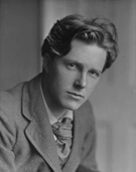The Grave and the Legend

The tomb which you see before you was not the original grave of Rupert Brooke. When Brooke died on the hospital ship in Tris Boukes Bay on the afternoon of 23rd April 1915, his fellow officers had little time to make elaborate arrangements. At 6 a.m. the following morning, they were due to join the campaign at Gallipoli. So Brooke was buried at night in a simple ceremony, and the original grave was a stone cairn. It bore a wooden cross inscribed in Greek with the words:
“Here lies the servant of God, Sub-lieutenant
in the English Navy,
who died for the deliverance of Constantinople
from the Turks”.
The current tomb was placed here shortly after the end of the First World War and is the work of the Greek sculptor Georgios Bonanos (1863-1940). It was commissioned by Brooke’s mother, who was concerned that the existing grave was little more than loose boulders. The concept was that of “medieval design adapted to Greek surroundings”, intended to convey an atmosphere of both precision and melancholy.
Inscribed on the grave is Brooke’s most famous poem, The Soldier. This was written in the last months of 1914, after his return from the fall of Antwerp. Although he had experienced the chaos of battle there, and seen the misery of the fleeing refugees, the full horror of the trenches was yet to be realised.
On its own, this poem created the lasting image of Brooke: first as a selfless idealist who died young for his country, and later (when cynicism set in) as a sentimental jingoist who glorified war. In fact, the reality is not so simple.
First of all, Brooke was a romantic, a golden youth who possessed considerable charisma. Virginia Woolf described him as “ . . .all that could be kind and interesting, substantial and good-hearted . . . he had such a gift with people, and such sanity and force . . .” Many of his other contemporaries shared this view, and his death while still young and beautiful sealed his immortality.
Next, Brooke was a poet, whose work represents the final flowering of romantic verse in English. Of just under a hundred poems he left, maybe a dozen are memorable: many of the others could be classed as juvenilia. Had he lived, he might have been a much finer poet, perhaps joining the roll-call of those great poets who recorded the horror and pointlessness of that war.
Thirdly, he was an idealist, and some of his idealism found its expression in the First World War, and in the 1914 Sonnets which include The Soldier. However, the letters he wrote after his experiences at the fall of Antwerp in Autumn 1914 also show that he was aware of much of the reality of war. And his last poem, Fragment, demonstrates development which could have led to him being numbered amongst the greatest of the First World War poets.
Finally, he was a politician. Brooke was a socialist, a student of Beatrice and Sidney Webb, and a vociferous campaigner for reform of the iniquitous poor law. Had he lived, he could well be remembered today as a Labour politician rather than as a poet. Many able political contemporaries of Brooke’s, such as Ben Keeling (who had organised Keir Hardie’s visit to Cambridge in 1907) also died in the war. But others, such as Hugh Dalton, went on to become Labour government ministers.
So the images which remain are incomplete and unfulfilled. In his 27 years he had become an established poet, travelled the World, been appointed fellow of a Cambridge college, become an naval officer, and gone to war. He had had passionate affairs with several women and one or two young men, possibly fathered a daughter in the South Seas, and endured the turmoil of a severe breakdown. He had mixed with the major political and literary figures of his time, and was regarded as one for whom greatness was destined. In his short life, he had fitted in more living than many of us manage in a full span.
